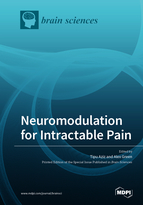Neuromodulation for Intractable Pain
A special issue of Brain Sciences (ISSN 2076-3425).
Deadline for manuscript submissions: closed (22 October 2019) | Viewed by 55293
Special Issue Editors
Interests: Parkinson’s disease; movement disorders; pain; functional neurosurgery
Special Issues, Collections and Topics in MDPI journals
Interests: deep brain stimulation; spinal cord stimulation; neuromodulation; pain; autonomic; movement disorders
Special Issues, Collections and Topics in MDPI journals
Special Issue Information
Dear Colleagues,
Over 7% of the Western population suffers from intractable pain. Despite pharmacotherapy, many patients (1.5%) suffer from refractory pain. In addition to the pain, patients continue to be highly debilitated and suffer from depression and anxiety, poor quality of life and loss of employment. An ever enlarging global problem concerns the use of opiates which have risen to dangerous levels. Neuromodulation of the nervous system—where the function of the nervous system is altered by a device—has, over time, emerged as an effective alternative to pharmacotherapy in the management of these patients.
In this Special Issue, we will discuss the indications, safety, efficacy, mechanisms of action and other aspects of neurmodulation therapies for pain relief. These include peripheral nerve stimulation, peripheral field stimulation, spinal cord stimulation, dorsal root ganglion stimulation, motor cortex stimulation and deep brain stimulation.
We do not intend this Special Issue to be a comprehensive study of pain but a guide to help clinicians to refer patients appropriately and to decide which procedure would best be offered in certain situations.
Prof. Dr. Tipu Aziz
Dr. Alex Green
Guest Editors
Manuscript Submission Information
Manuscripts should be submitted online at www.mdpi.com by registering and logging in to this website. Once you are registered, click here to go to the submission form. Manuscripts can be submitted until the deadline. All submissions that pass pre-check are peer-reviewed. Accepted papers will be published continuously in the journal (as soon as accepted) and will be listed together on the special issue website. Research articles, review articles as well as short communications are invited. For planned papers, a title and short abstract (about 100 words) can be sent to the Editorial Office for announcement on this website.
Submitted manuscripts should not have been published previously, nor be under consideration for publication elsewhere (except conference proceedings papers). All manuscripts are thoroughly refereed through a single-blind peer-review process. A guide for authors and other relevant information for submission of manuscripts is available on the Instructions for Authors page. Brain Sciences is an international peer-reviewed open access monthly journal published by MDPI.
Please visit the Instructions for Authors page before submitting a manuscript. The Article Processing Charge (APC) for publication in this open access journal is 2200 CHF (Swiss Francs). Submitted papers should be well formatted and use good English. Authors may use MDPI's English editing service prior to publication or during author revisions.
Keywords
- Neuropathic pain
- Neuromodulation
- Intractable pain
- depression and anxiety
- nervous system








